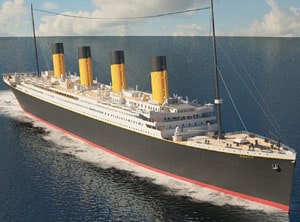English Documentary on Titanic with Transcript and flashcards inside the lesson to improve your listening and reading comprehension and enrich your academic vocabulary
Source of documentary: National Geographic YouTube Channel
The Titanic
The turn of the 20th century saw a golden age of industry and prosperity in many Western countries. One aspect of this era came to epitomize its grandeur and ultimately its downfall: the Titanic.
Constructing the giant ship
Commissioned by the British shipping company, White Star Line, the Titanic was created to satiate demand for luxury travel between Europe and North America. The ship’s construction began in March 1909 in Belfast, Ireland. By the time it was sent to England for provisions, Titanic was one of the largest ships of its time. It was about 92 feet wide and 882.5 feet long, the length of nearly three football fields. With a height of about 175 feet, the ship above water was taller than most buildings.
Titanic’s safety features
The Titanic also included new safety features such as 16 compartments designed to prevent the hull from flooding; this caused many to believe that the ship was unsinkable. Such confidence led to the unfortunate decision to cut the number of lifeboats on board in half, in order to make the deck look clean and elegant.
The disastrous voyage
On April 10, 1912, Titanic left port in Southampton, England and embarked on its first and last voyage. It first stopped over in France and Ireland, and by the time it set out on a long stretch of sea toward New York City, it had about 2,200 people on board. Unbeknownst to all, misfortune would arise just a few days into their voyage.
On April 14, at approximately 09:40 and 10:55 PM, warnings were sent to the Titanic’s radio operators of ice fields, but they were never relayed to the bridge. At about 11:40 PM nearly 500 miles off the coast of Newfoundland, Canada, lookout crew on the Titanic spotted an iceberg in the ship’s path and sent word to the bridge, but it was too late. The iceberg grazed the right side of the ship, causing its compartments, originally deemed watertight, to fill with water.
Sinking of the unsinkable
Titanic’s radio operators began sending out distress signals. At 12:20 AM, one signal reached the ship Carpathia, which began making its way to the Titanic at maximum speed. Around the same time, crew began loading women and children into the few lifeboats on board. In addition to the shortage of lifeboats, some of the ones used were not being filled to capacity, stranding even more people on the sinking ship.
For the next two hours, the front compartments of the Titanic filled with water, causing the bow to sink, and the stern to rise out of the water. At around 02:18 AM the ship snapped into two, the bow sank first, followed by the stern, a couple of minutes later. Those who went down with the ship, were left in the freezing waters. Over an hour later at about 03:30 AM, the Carpathia arrived to pick up passengers. Of the 2,200 people on the Titanic, only 705 survived.
Reconsidering safety measures
Soon after the disaster, both the United States and Great Britain conducted investigations and developed new safety measures for ships. They required ships to maintain a 24-hour radio watch and have enough lifeboats for all on board. They also helped establish the International Ice Patrol, which monitors icebergs in the North Atlantic, and warns ships of potential dangers.
Discovery of the shipwreck
For decades, Titanic was lost to the sea, existing only as a ghost from a decadent past. In 1985, nearly 75 years after the ship sank, a team led by National Geographic Explorer-at-Large, Bob Ballard, discovered the shipwreck off the coast of Canada. Little by little, scientists have reconstructed the ship and its encounter with the iceberg, giving us a better understanding of what exactly happened on that fateful day.




Also I just come up with another question:
Why Titanic is referred as a she?
Such a very good question!
This is a sign of personification in English when we give life to inanimate objects to glorify them. Another example is when we refer to cities like New York as she, e.g. the following phrase is very common in American English:
Look at New York, isn’t she a beauty?
And if you’re curious to know why we use a feminine pronoun rather than a masculine one, I should say that, most probably, because the entities that this pronoun, i.e. she refers to are fairly adorable, motherly, and amicable.
Hello Dr.Hariri, I have two questions on the passage:
What is the meaning of ( a decadent past ) and ( Explorer-at-Large ) ?
Hi Armaghan. So delighted to see your questions here!
The phrase, decadent past, refers to the process of decaying in the passage of time, because the Titanic’s wreckage was decaying and being decomposed over the last 75 years when the National Geographic’s professional crew could retrieve the shipwreck in 1985.
About “at-Large”, please note that this is a proper noun because Large is capitalized. So it must be a title or name for the above-mentioned explorer. However, the word ‘at-large’ means free of any limitations, free and unconfined. It must imply that the explorer can reach any spot on earth freely.
It is interesting to know that our dictionary includes these 2 words with the links below:
Be at large:
https://lelb.net/be-at-large-1100-words/
And decadence:
https://lelb.net/decadence-1100-words-you-need/
The Titanic
The turn of the 20th century saw a golden age of industry and prosperity in many Western countries. One aspect of this era came to epitomize its grandeur and ultimately its downfall: the Titanic. Commissioned by the British shipping company, White Star Line, the Titanic was created to satiate demand for luxury travel between Europe and North America. The ship’s construction began in March 1909 in Belfast, Ireland. By the time it was sent to England for provisions, Titanic was one of the largest ships of its time. It was about 92 feet wide and 882.5 feet long, the length of nearly three football fields. With a height of about 175 feet, the ship above water was taller than most buildings. The Titanic also included new safety features such as 16 compartments designed to prevent the hull from flooding, this caused many to believe that the ship was unsinkable. Such confidence led to the unfortunate decision to cut the number of lifeboats on board in half, in order to make the deck look clean and elegant.
On April 10, 1912, Titanic left port in Southampton, England and embarked on its first and last voyage. It first stopped over in France and Ireland, and by the time it set out on a long stretch of sea toward New York City, it had about 2,200 people on board. Unbeknownst to all, misfortune would arise just a few days into their voyage. On April 14, at approximately 09:40 and 10:55 PM, warnings were sent to the Titanic’s radio operators of ice fields, but they were never relayed to the bridge. At about 11:40 PM nearly 500 miles off the coast of Newfoundland, Canada, lookout crew on the Titanic spotted an iceberg in the ship’s path and sent word to the bridge, but it was too late. The iceberg grazed the right side of the ship causing its compartments, originally deemed watertight, to fill with water. Titanic’s radio operators began sending out distress signals. At 12:20 AM one signal reached the ship Carpathia, which began making its way to the Titanic at maximum speed. Around the same time, crew began loading women and children into the few lifeboats on board. In addition to the shortage of lifeboats, some of the ones used were not being filled to capacity, stranding even more people on the sinking ship. For the next two hours, the front compartments of the Titanic filled with water, causing the bow to sink, and the stern to rise out of the water. At around 02:18 AM the ship snapped into two, the bow sank first, followed by the stern, a couple minutes later. Those who went down with the ship, were left in the freezing waters. Over an hour later at about 03:30 AM, the Carpathia arrived to pick up passengers. Of the 2,200 people on the Titanic, only 705 survived.
Soon after the disaster, both the United States and Great Britain conducted investigations and developed new safety measures for ships. They required ships to maintain a 24-hour radio watch and have enough lifeboats for all on board. They also helped establish the International Ice Patrol, which monitors icebergs in the North Atlantic, and warns ships of potential dangers.
For decades Titanic was lost to the sea, existing only as a ghost from decadent past. In 1985, nearly 75 years after the ship sank, a team led by National Geographic Explorer-at-Large, Bob Ballard, discovered the shipwreck off the coast of Canada. Little by little scientists have reconstructed the ship and its encounter with the iceberg, giving us a better understanding of what exactly happened on that fateful day.
So many thanks for your accurate transcription.
The only minor mistake is found in the last paragraph: a decadent past “a” was not transcribed.